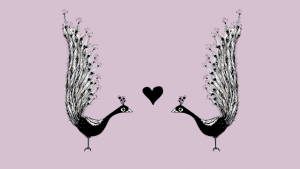Darwinian natural selection favours the fittest organisms. From an evolutionary perspective, fit animals are essentially those that survive and produce the most offspring. Homosexual behaviours occurring across the animal kingdom, from flamingos to bison, seem at odds with the latter point. Obviously, offspring cannot be produced from same-sex copulation, so fitness is reduced to zero. However, there are now numerous adaptive hypotheses reconciling homosexual behaviour with Darwinian theory. Bottlenose dolphins exemplify these theories for male-male interactions, whilst macaques do the same for female-female contact.
Off the coast of Weymouth in 2002, George the dolphin became a cause for concern when he became sexually aggressive and attempted to mate with swimmers: an extreme expression of the normally playful sexual nature of dolphins. It has recently been discovered through careful studies of pods in the Indian Ocean, that this extends to homosexual behaviour. Male dolphins in particular form small groups in which they mount each other in sexual positions or make contact with the genital area with the beak or pectoral fin.
These homosexual interactions primarily appear to function in establishing long-term social structure. Trust between pod members is needed when exposing the delicate genital area to others, and this trust facilitates long-term social bonds. Also, the intimate exploration of other individuals’ physical attributes gives members of the group a better knowledge of the strengths and weaknesses of allies. The resultant cohesive and well organised group then gains the upper hand in competitive and conflict situations with other pods.
Another potential function of close contact is to allow assessment of physical asymmetries, with repeated interactions contributing to the establishment of dominance hierarchies. If one male is stronger than the others, he can mount more often and establish himself as the alpha male, with clear benefits to his own fitness.
Homosexual behaviour occurs most often amongst dolphin calves, suggesting a further, more direct sexual benefit to the calves alone. Perhaps they use homosexual interactions as practice for heterosexual activities like courtship and copulation—honing social and motor skills that can be employed in a heterosexual context later in life. So, in general, dolphin male-male homosexuality might not directly contribute to reproductive success, but in contributing to social structure it sets these mammals up to be fecund in the future.
Macaques, in contrast, frequently indulge in female-female sexual interactions. Again, although these can be immediately costly for the female, they can still contribute to increased fitness in the future.
For instance, these same-sex acts potentially function to attract males that might be otherwise reluctant to mate. By mimicking the copulatory movements of rival males, a mounting female may encourage a dominant male into genuine copulation (he wants to spread his sperm before his rivals). The female benefits from his good-quality sperm. Equally, the mountee may benefit by showing she is sexually receptive and willing to mate. If the females are related, there may be some kin selection going on too: even if the interaction is costly to one partner, she may tolerate it given that her sister or mother (with whom genes are shared) will benefit.
A less altruistic alternative, though perhaps more in line with natural selection, is that the mounting female does so to remove competition for males between females. By providing an alternative form of sexual stimulation, the mounter reduces the receptivity of the mountee to future matings. Consistent with this, fertile female stumptail macaques are more likely to be mounted than less fertile females.
Natural selection favours females that engage in heterosexual interactions, with obvious benefits in terms of offspring production. This behaviour may well be practised on other females, but crucially, if homosexual encounters are not particularly costly, they will not be selected against.
At first glance, homosexual animals appear to violate a fundamental law of nature. But looking more closely, and remembering that animals might invest in the future as well as current sexual opportunities, suggests they may actually reap fitness benefits. Sure, the current opportunity to produce offspring is missed, but homosexual social exploitation and manipulation can provide opportunities for heterosexual, naturally-favoured sex in the future.
Nigel Taylor is a 3rd year undergraduate studying Biological Sciences at Jesus College.
Art by Elizaveta Gelfreykh.
![Queer Beasts Darwinian natural selection favours the fittest organisms. From an evolutionary perspective, fit animals are essentially those that survive and produce the most offspring. Homosexual behaviours […]](/wp-content/uploads/2011/10/Queer-beasts_preview-620x300.png)
